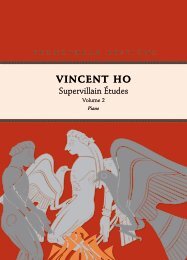Create successful ePaper yourself
Turn your PDF publications into a flip-book with our unique Google optimized e-Paper software.
Following Bartók’s death, Tibor Serly, a compatriot friend <strong>and</strong> fellow composer, undertook<br />
the difficult task of deciphering the manuscript <strong>and</strong> preparing it for performance. Both Serly<br />
<strong>and</strong> Primrose worked together to prepare the score which Boosey & Hawkes published in<br />
1950. We owe them a debt of gratitude for their faith in the importance of this masterpiece.<br />
The <strong>Viola</strong> <strong>Concerto</strong>, initially dismissed as an unfinished sketch, has become a staple of the<br />
viola repertoire.<br />
My motivation in undertaking this critical <strong>restoration</strong> was the discovery that the Boosey &<br />
Hawkes publication contained many divergences from Bartók’s manuscript. Whilst we have<br />
no power to bring Bartók back to give us his definitive version, I believe we must follow<br />
as closely as we can the notes he did write. What remains is a very powerful <strong>and</strong> concise<br />
concerto, the “swan-song” of Béla Bartók.<br />
This edition is intended to serve as a basis for practical performance. Virtually all indications<br />
of tempo, mood, expression <strong>and</strong> articulation are editorial, <strong>and</strong> the occasional slurs supplied<br />
by the composer are not distinguished in this full score. Some of the sections which were<br />
left blank in the manuscript <strong>and</strong> filled by Serly have been retained but thoroughly revised.<br />
In my piano reduction (PE066), those few markings that were supplied by the composer are<br />
identified in parentheses, <strong>and</strong> a detailed critical apparatus is included so that comparison<br />
may be made with the work as it appears in the original manuscript draft. Thus, informed<br />
decisions may be taken by the performer with regards to the editorial suggestions made<br />
throughout the score.<br />
The choices of instrumentation presented in this score evolved over a period of ten years. I<br />
have studied all of Bartók’s works involving orchestra, examining the first drafts of many of<br />
these <strong>and</strong> immersing myself in identifying with the composer’s process of <strong>orchestration</strong>. In<br />
the <strong>Viola</strong> <strong>Concerto</strong> I see thematic links to such earlier compositions as the Violin <strong>Concerto</strong><br />
No.1, Bluebeard’s Castle, The Miraculous M<strong>and</strong>arin, Dance Suite, Rhapsody No.2 for violin<br />
<strong>and</strong> orchestra, Cantata Profana, String Quartet No.5, Music for Strings, Percussion <strong>and</strong><br />
Celesta, Violin <strong>Concerto</strong> No.2, <strong>Concerto</strong> for Orchestra <strong>and</strong> Piano <strong>Concerto</strong> No.3. All these<br />
works, even the string quartet, have had some particular influence on my orchestrating the<br />
<strong>Viola</strong> <strong>Concerto</strong>.<br />
During those ten years I made a number of variants of the score, <strong>and</strong> I am grateful for the<br />
support of several conductors <strong>and</strong> orchestras who kindly gave me a great deal of rehearsal<br />
time <strong>and</strong> the incomparable opportunity to try out different ideas of instrumentation which<br />
PE065 – iv


















